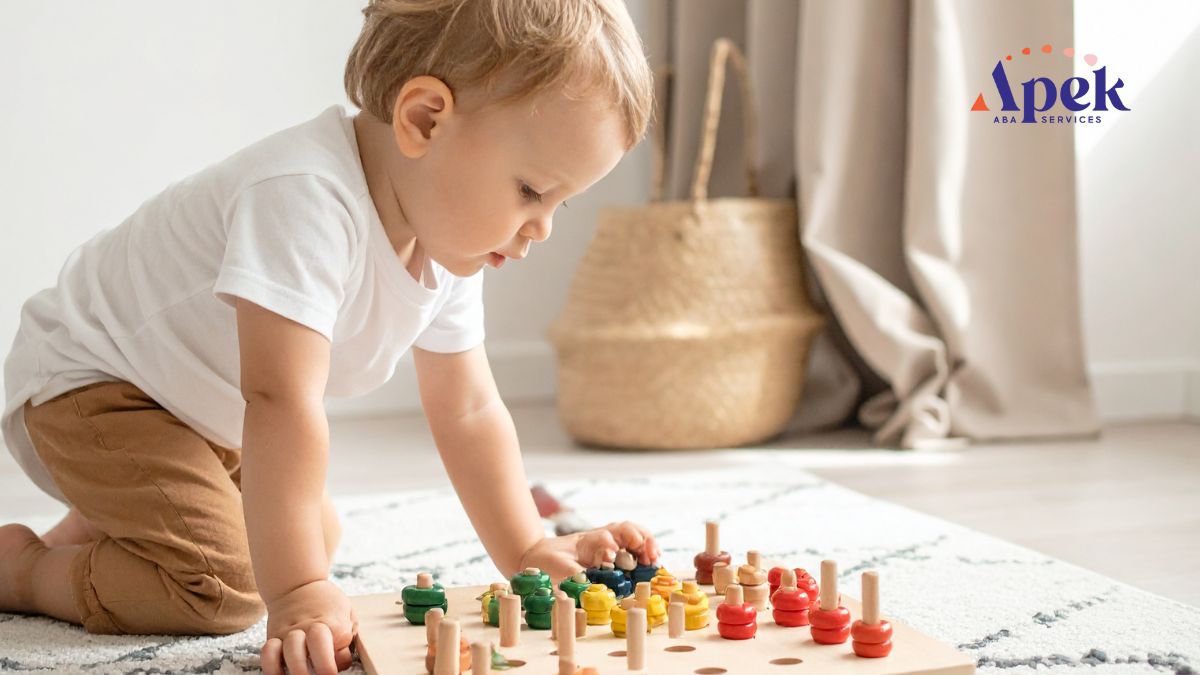Key Points:
- Early signs of autism in toddlers include poor eye contact, no response to name, limited gestures, repetitive play, or speech delays.
- Parents should seek an ABA evaluation if two or more signs persist, skills regress, or daily routines break down.
- Early action improves outcomes and shortens wait times.
Worry grows when a toddler avoids eye contact, ignores their name, or lines up toys for long stretches. Early signs of autism in toddlers point to developmental differences that show up in social interaction, communication, play, and behavior. Parents do not need to wait for a formal label to start getting help or to request an ABA evaluation.

What are the early signs of autism in toddlers?
Parents often notice patterns across everyday moments long before formal testing. Early signs of autism in toddlers span social cues, language, play, movement, and sensory responses. These early signs in toddlers can look different from signs of autism in older children.
One sign alone may not tell the whole story; clusters that persist across settings deserve attention. Knowing what to watch for helps you track change over a few weeks instead of reacting to a single hard day.
Use this list to organize your notes. Bring examples and short videos to your pediatric visit.
- Name response: The toddler does not reliably look or turn when called by name by 9–12 months.
- Eye contact and shared attention: The toddler uses less eye contact and rarely points to share interest, like pointing at an airplane for you to see.
- Gestures: The toddler waves, claps, or nods less often, or uses your hand as a tool instead of pointing.
- Imitation and play: The toddler copies fewer actions, does little pretend play, or focuses on parts of toys rather than using them for play.
- Language patterns: The toddler says fewer words, loses words, or repeats scripts from shows out of context. ABA communication can teach simple requests and early turn-taking in daily routines.
- Repetitive behaviors: The toddler lines up objects, watches spinning items, or repeats movements for long periods.
- Sensory responses: The toddler covers ears, avoids certain textures, or seeks spinning and jumping more than peers.
When should you seek an ABA evaluation?
The American Academy of Pediatrics recommends autism screening at 18 and 24 months during well-child visits. The same guidance urges referrals for intervention as soon as delays appear rather than waiting for a diagnostic appointment to finish.
A broad view helps put timing in context. In U.S. data, about 1 in 31 children are identified with autism, and boys are identified over 3 times as often as girls. These figures tell parents that concern is common and action is expected, not rare.
Timing depends on patterns, persistence, and impact. Consider urgency in light of current U.S. timing. The median age of earliest known autism diagnosis is about 47 months, which means many children wait until preschool or later. Families can shorten that wait by asking for referrals at the first concern.
Look for these triggers to request an ABA evaluation:
- Multiple red flags: Two or more signs from the checklist persist across home and daycare.
- Regression: The toddler stops using words, gestures, or eye contact that were present a month earlier.
- Safety or daily function: Rigid routines, high-risk behaviors, or meltdowns limit sleep, feeding, or play. ABA parent training tips focus on reducing triggers, teaching clearer requests, and building a simple safety plan at home.
- High family concern: Parents or caregivers feel stuck after trying simple changes for several weeks.
Ask your pediatrician for screening tools and referrals. Many clinics use the M-CHAT-R/F at 16–30 months. If the screen suggests elevated likelihood, request a full evaluation and ask about starting parent-guided strategies, such as support ABA therapy from home while waiting.
Early Signs of Autism in Toddlers Checklist: How to Use It at Home
A simple checklist helps you track patterns without guessing. Keep it low-stress and practical. Observe during short windows at consistent times, and share results with your pediatrician and ABA team if you move forward.
Start with three short sessions per week for two weeks. Choose a quiet time and one routine, such as snack, bath, or play on the floor. Note what you see, not what you think it means, and write down exact examples with dates.
- Social sharing: The toddler points to show or brings you an item to share interest at least once in a 10-minute play block.
- Back-and-forth: The toddler takes turns in a simple game like rolling a ball or playing “pat-a-cake” for at least three exchanges.
- Name response: The toddler turns to their name within two tries during routine play.
- Gestures and imitation: The toddler waves, nods, claps, or copies your action during songs or games.
- Play style: The toddler uses toys for pretend play or varied play rather than only lining, sorting, or spinning.
- Language use: The toddler uses words to request or label, and repeats fewer scripts from shows.
- Sensory notes: The toddler shows strong reactions to sounds, lights, or textures that disrupt play.
Bring this mini-log to your visit. A simple, dated list often speeds referrals and makes the evaluation smoother.
What happens during an ABA evaluation?
An ABA evaluation looks at strengths, challenges, and daily routines. Teams review parent interviews, observe play, and use standardized tools to map skills in communication, social interaction, learning, and behavior. All these follow the ABA therapy explained approach of identifying why behavior happens and teaching positive alternatives.
Expect several steps.
- First comes history and current concerns, then structured play and observation.
- Some providers include caregiver-completed forms to rate skills at home and in the community.
- Many teams will collaborate with your pediatrician, speech therapist, or occupational therapist to gather a full picture.
- If results point toward autism or related delays, the team drafts measurable goals and a plan for parent-led strategies you can start right away.
Parents receive clear next steps: recommended hours, parent training sessions, and starter strategies for communication and play. Ask how progress will be measured in the first 90 days and how goals will be adjusted as new skills emerge.
Why early action supports better outcomes
Early brain development changes quickly in the toddler years. When support begins during this window, many children build language, imitation, and daily living skills faster.
Controlled studies back this up. In one well-known trial using a developmental ABA model for toddlers, the intervention group showed an average IQ increase of about 15 points over the first year, compared with about 4 points in the comparison group.
Diagnosis often arrives late. The median diagnosis still occurs around 47 months, but pediatric guidance urges earlier screening and immediate referral to services when delays are seen. Families can close that gap by requesting referrals at the first concern and by starting parent-guided strategies while formal steps move forward.

Frequently Asked Questions
What is Stage 1 autism in toddlers?
Stage 1 autism in toddlers refers to “Level 1” support needs, where a child shows mild but noticeable social and behavioral differences. Toddlers may use words but struggle with interaction, flexibility, or change. Evaluation guides support, often including parent-coached ABA to build skills in daily routines.
What does high-functioning autism look like in a 2-year-old?
High-functioning autism in a 2-year-old may involve early speech or letter skills alongside limited eye contact, name response, or pretend play. Rigid routines, repetitive actions, and sensory sensitivities are common. Despite strong areas, support is needed to build joint attention, imitation, and flexible play through targeted intervention.
What is the biggest indicator of autism?
The biggest indicator of autism is reduced joint attention, such as not pointing to share interest or lacking back-and-forth play. When combined with delayed gestures, limited pretend play, or repetitive behaviors, concern increases. Clusters of these signs over weeks should prompt early screening and ABA evaluation.
Start an Evaluation: Schedule ABA Services for Your Toddler
Parents who act on early signs reduce stress at home and open space for faster skill growth. ABA therapy services in Georgia and Virginia are available for children with ASD. At Apek ABA, teams explain each step, set measurable goals, and coach caregivers so strategies fit daily routines.
Families can expect a clear plan for the first 90 days and updates based on progress. Reach out to schedule an intake and ask about waitlist options, insurance support, and parent training sessions.

